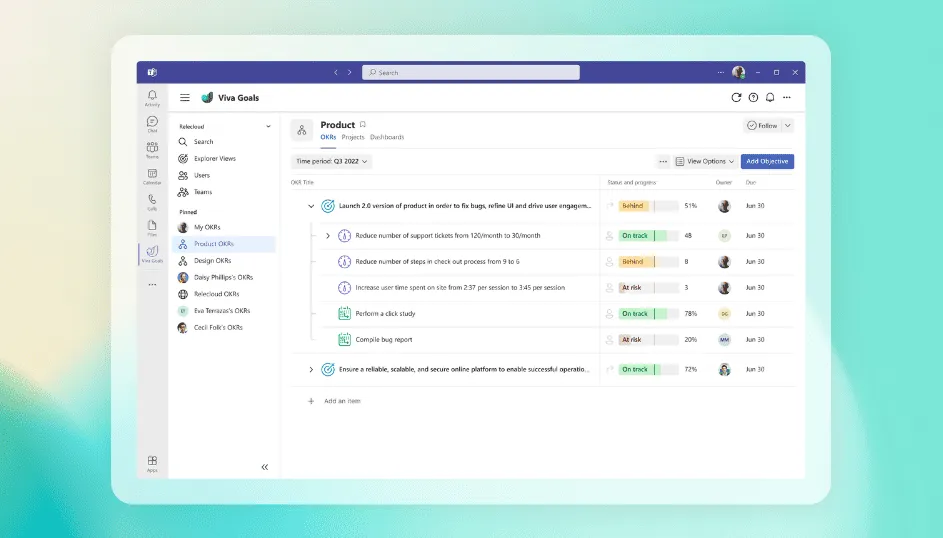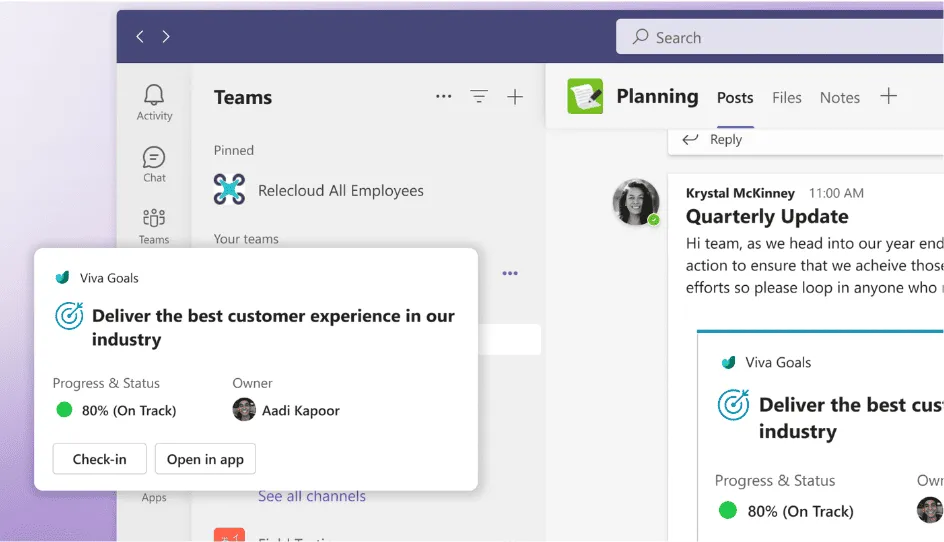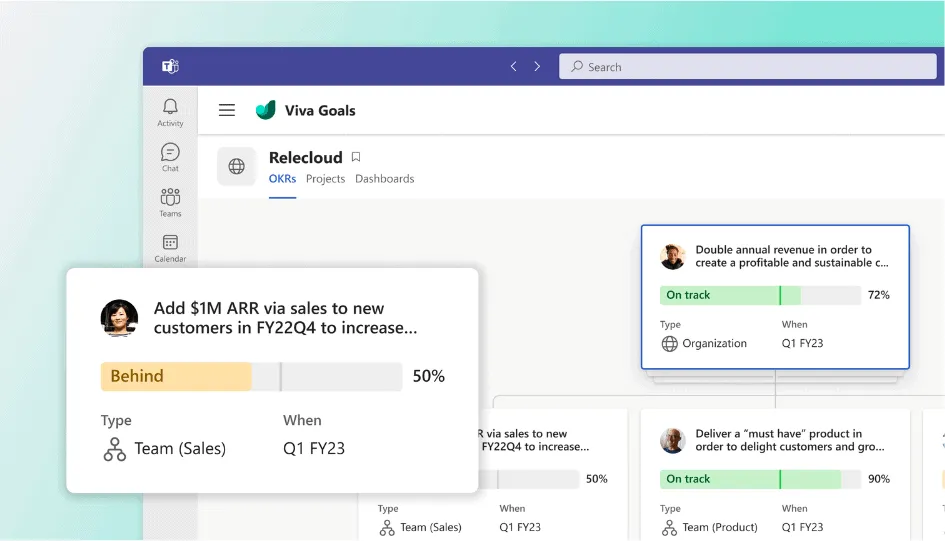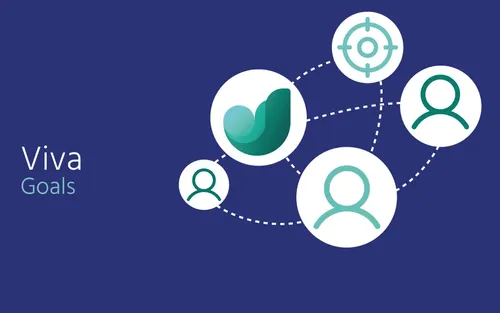
Knowledge base
April 09, 2023
Introducing Microsoft Viva Goals: the newest member of the Microsoft Viva family
Microsoft Viva is a set of features Microsoft has bundled into a brand for employee experiences. Some of these features are available through a Microsoft 365 license. There are paid features that can also be licensed separately, or all together with Viva suite licenses.
What is Viva Goals?
Viva Goals is an app that we can implement within Microsoft Teams, as well as a web application that can be accessed through their Internet browser. From the Microsoft Viva Goals page, we need to use Viva Goals to:
- Create, manage, align and customize OKR workflows with OKR templates, automated check-ins and advanced insights.
- Boost business rhythms with OKRs using shared dashboards and advanced insights.
- Connect work to results with deep integrations with tasks, projects and embedded OKR views.
- Integrate into critical tools, such as Teams, Slack and Glip, to enable automated OKR check-ins.
- Benefit from enterprise scale and security with SSO capabilities, data encryption, SOC 2 Type II compliance, enterprise-level privacy and advanced permissions.
- Use advanced OKR configurations with customizable weights and scoring guidance.

That all makes perfect sense, right? It would be if we were already familiar with OKRs and what it all means. OKR stands for Objectives and Key Results. A goal-setting framework used at the organizational, team and individual levels to define measurable goals to track their results.
What are goals and key outcomes?
When I learn about a business management framework or a technique I’ve never heard of, I always look at where it came from, its history and some of the criticism surrounding it. In the business world, there is a lot of marketing around simple solutions to complex problems. Sometimes when we communicate a framework or technique over time, the original intent is lost or distorted.
So, Objectives and Key Results (OKRs), developed in the 1970s, by Andrew Grove, introduced this approach to Intel in the 1970s. John Doerr, at that time a salesman, took a course at Intel taught by Grove. Years later, Doerr, now working at a venture capital firm, introduced the idea to Google. There, it quickly became central to Google’s culture as a management method. Doerr later published a book on the OKR framework called Measure What Matters in 2018.

Ok, history lesson over! Let’s see what the framework for goals and core outcomes is. OKRs are composed based on an OBJECTIVE, three to five associated KERN RESULTS, which are supported by INITIATIVES.
Objective: Where do we want to go?
- Objective: Where do we want to go?
- Goals should be clear, inspiring, public stretch goals that are shared throughout the organization.
- Because OKRs are meant to sharpen focus throughout the organization, there should be no more than 5 objectives.
- Targets should be at least quarterly so that the focus can be shifted as circumstances change.
- Example – Deliver a “delightful” sales experience.
- Key Outcomes: How do we know we are getting where we want to go?
- 3-5 Main results by objective
- Each key result must have a focus, a measurement and be ambitious.
- The idea is to define the key outcomes that we meet 70% of the time. We should not be sure that we will get all the important results.
- Examples
- Increase average satisfaction score of surveyed prospects from 7.5 to 8.5
- Reduce sales cycle from 40 to 28 days
- Increase the referral rate from 5% to 10%
- Initiatives: What do we need to do to get there?
- The group of tasks and activities that must be done to achieve key outcomes.
- Examples
- Interview prospects with lower satisfaction to identify trends
- Map sales cycle and target steps for improvements and automation
- Create a formal referral program to encourage customers to refer us to others
- OKRs are NOT:
- Unrealistic or vague goals
- An exhaustive task or to-do list of everything that needs to be done each day (that’s project planning!)
- Too specific to be restrictive and inflexible when new information is available.
I just scratched the surface on this, so if you want to know more, check out the OKR Leadership Program and Get Started with Microsoft Viva Goals Microsoft Learning Paths.
What does a Viva Goals Implementation look like?
An implementation of Viva Goals really should not begin until an organization has committed to adopting OKRs as a practice. They have already experimented with the method in small groups, received executive sponsorship to adopt OKRs, and they have widely incorporated this concept into corporate rhythms. Until now, they have been using a series of spreadsheets to define OKRs and update key results within the organization. If your organization has adopted the OKR methodology and is preparing to scale it to the entire organization, this is where you select and implement an OKR tool, and that’s where Viva Goals comes in.

I would recommend a timeline of 4-8 weeks when launching Viva Goals in an organization. This includes pre-launch activity to raise awareness, highlight the value or why behind implementation, and provide user guides and training. At the same time, the tenant administrators are preparing the environment and Microsoft Teams to deploy the app. Then work with the OKR champions to load the first set of goals and key outcomes into Viva goals. On launch day, the focus shifts to ongoing communication that presents the user experience, illustrates specific scenarios, as well as important tips for Viva Goals based on initial launch feedback.
My position
I saw management trying to use okr’s in performance reviews for individuals. Or even the sense of management linking OKRs to compensation tainting adoption. I also think ill-defined goals can encourage behavior that causes “the numbers to go up” in the short term, but harmful in the long term. There will be a lot of experimentation, learning and some failures rolling out OKRs and Viva Goals. I believe that organizations with a low cultural tolerance for failure and learning will struggle to successfully implement the OKR concept.
There is a lot of focus on outcomes. I worry about an implementation that puts too much focus on results while not praising individual efforts. Studies have shown that praising people for their efforts (which an individual fully controls) versus outcomes (which an individual rarely fully controls), leads to better performing individuals over time. A good manager will be aware of this. Be sure to praise the efforts of their teams, because OKRs tend to be ambitious and not all of them will be met.
Overall, I am curious about Viva Goals and Objective and Key Results, and I will write more in the future as I learn more about the tool and its framework. I believe that when well thought out and communicated, goals and key outcomes can help an organization set ambitious goals, encourage focus on those goals, and enable teams and individuals to adapt within those organizational goals.
Source: totalsol
Want to know more?

Related
blogs
Tech Updates: Microsoft 365, Azure, Cybersecurity & AI – Weekly in Your Mailbox.









